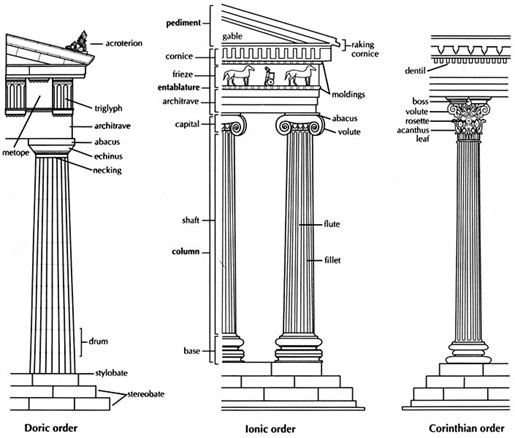Greek architecture is important for several reasons: (1) Because of its logic and order. Logic and order are at the heart of Greek architecture. The Hellenes planned their temples according to a coded scheme of parts, based first on function, then on a reasoned system of sculptural decoration. Mathematics determined the symmetry, the harmony, the eye’s pleasure.
There had never been an architecture in just this sense. Egyptian pyramid architecture had been an early, attempt, but Greek building art offered the first clear, strong expression of a rational, national architectural creed. It is the supreme example of the intellect working logically to create a unified aesthetic effect. Greek designers used precise mathematical calculations to determine the height, width and other characteristics of architectural elements. These proportions might be changed slightly, and certain individual elements (columns, capitals, base platform), might be tapered or curved, in order to create the optimum visual effect, as if the building was a piece of sculpture. (2) Because of its invention of the classical “orders”: namely, namely, the Doric Order, the Ionic Order and the Corinthian Order – according to the type of column, capital and entablature used. (3) Because of its exquisite architectural sculpture. Architects commissioned sculptors to carve friezes, statues and other architectural sculptures, whose beauty has rarely, if ever, been equaled in the history of art. (4) Because of its influence on other schools. Although Greek architects rarely progressed further than simple post-and-lintel building techniques, and failed to match the engineering techniques (arch, vault) developed in Roman architecture, they succeeded in creating the most beautiful, monumental structures of the Ancient World. Their formulas – devised as far back as 550 BCE – paved the way for Renaissance and Neoclassical architecture, and had the greatest possible influence on the proportions, style and aesthetics of the 18th and 19th centuries. Modern architects, too, have been influenced by Greek architectural forms. Louis Sullivan (1856-1924), for instance, a leading figure in the First Chicago School, based a number of his skyscraper designs on the Greek template of base, shaft, and capital, while using vertical bands (reminiscent of the fluting on Greek columns) to draw the eye upwards.
….
Unlike their Minoan and Mycenean ancestors, the Ancient Greeks did not have royalty, and therefore had no need for palaces. This was why their architecture was devoted to public buildings, such as the temple, including the small circular variant (tholos); the central market place (agora), with its covered colonnade (stoa); the monumental gateway or processional entrance (propylon); the council building (bouleuterion) the open-air theatre; the gymnasium (palaestra); the hippodrome (horse racing); the stadium (athletics); and the monumental tomb (mausoleum). But of all these buildings, it is the temple that best captures the qualities of Greek design.
http://www.visual-arts-cork.com/architecture/greek.htm#buildings
and
https://artincontext.org/greek-architecture/
Analysis
This article was interesting to me because it gives an overview of Greek architecture in context, and it highlights its structural integrity and beauty. Greek architecture even today is praised and studied for its intelligent structure and artistic decoration, yet modern architecture has moved into a more simplistic and minimalist approach. I chose this article because it made me wonder how different out world might look if Greek styles still influenced more of our architecture today. I hope to learn something about Greek architectural integrity and style, and maybe incorporate what I learn into my final project.
Take-Aways
There is beauty in intricate and precise details
How might I juxtapose sharp geometry with natural, flowing forms?




